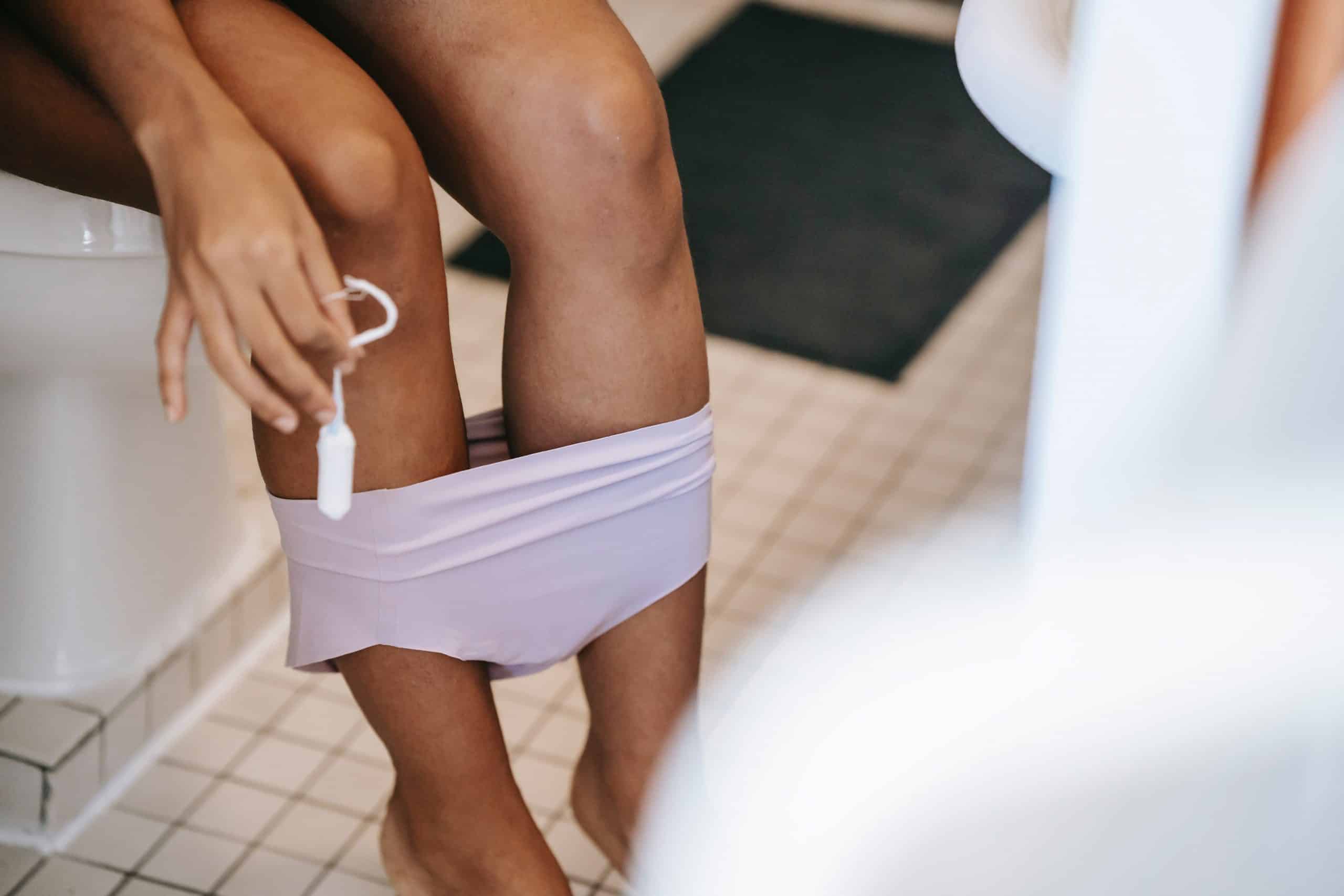Soon after I got my first period, my mother handed me a box of Tampax and showed me how to use tampons. At the end of our lesson, my mother told me that under no circumstances was I ever to leave a tampon in for more than four hours at a time, or I could risk getting toxic shock syndrome (TSS), which could kill me. Um, say what now, Mom?!  After my mother’s ominous warning, I was almost too scared to use tampons, so I followed the instructions on the tampon box to the letter. I mean, who wants their tombstone to read, “Here lies Katie Martin. She’d still be alive if she’d only taken her tampon out”? Still, in the almost 20 years that I’ve been using tampons, I’ve never fully understood what toxic shock syndrome was, nor had I ever heard of anyone actually contracting the illness.
After my mother’s ominous warning, I was almost too scared to use tampons, so I followed the instructions on the tampon box to the letter. I mean, who wants their tombstone to read, “Here lies Katie Martin. She’d still be alive if she’d only taken her tampon out”? Still, in the almost 20 years that I’ve been using tampons, I’ve never fully understood what toxic shock syndrome was, nor had I ever heard of anyone actually contracting the illness.  I wondered: Is toxic shock syndrome really that scary? Here’s what the experts have to say.
I wondered: Is toxic shock syndrome really that scary? Here’s what the experts have to say.
What really causes toxic shock syndrome?
“Toxic shock syndrome (TSS) is an extremely rare illness caused by Staphylococcus aureus or group A Streptococcus bacteria,” explains Tami Prince, MD, the leading OB-GYN at the Women’s Health and Wellness Center of Georgia. “These bacteria can produce toxins which enter into the bloodstream and cause sepsis, ultimately leading to death if left untreated.”  According to Prince, tampons aren’t the only way to get toxic shock syndrome. That’s why menstruating women aren’t the only ones at risk for the illness. Men, young children, and post-menopausal women are also at risk for this rare disease. In fact, toxic shock syndrome caused by Staphylococcus aureus is most often the result of a localized infection, such as one that may occur after surgery or in an open wound. TSS caused by Staphylococcus aureus is much less deadly than cases of toxic shock syndrome caused by group A strep (Streptococcus pyogenes) as the mortality rate of toxic shock syndrome associated with this staph is between 5 and 15 percent.
According to Prince, tampons aren’t the only way to get toxic shock syndrome. That’s why menstruating women aren’t the only ones at risk for the illness. Men, young children, and post-menopausal women are also at risk for this rare disease. In fact, toxic shock syndrome caused by Staphylococcus aureus is most often the result of a localized infection, such as one that may occur after surgery or in an open wound. TSS caused by Staphylococcus aureus is much less deadly than cases of toxic shock syndrome caused by group A strep (Streptococcus pyogenes) as the mortality rate of toxic shock syndrome associated with this staph is between 5 and 15 percent.  Group A strep (Streptococcus pyogenes) is a less-common cause of TSS, but toxic shock syndrome caused by strep is much more serious, with mortality rates estimated to be as high as 70 percent.
Group A strep (Streptococcus pyogenes) is a less-common cause of TSS, but toxic shock syndrome caused by strep is much more serious, with mortality rates estimated to be as high as 70 percent.
So why do tampons get blamed for most cases of toxic shock syndrome?
“Toxic shock syndrome can occur in any gender or age group but about half of all cases occur in menstruating woman,” says Prince. To understand why, you have to know a little bit about the history of the tampon.  “Toxic shock syndrome was first described in 1920s, but became very well known in the 1980s after it was associated with high-absorbency tampons,” Amesh Adalja, MD, a board-certified infectious disease physician at the Johns Hopkins Center for Health Security, tells HealthyWay. That’s because high-absorbency tampons meant women could go longer without changing them, providing a breeding ground for bacteria to thrive. According to Prince, “Increased blood absorption with prolonged use as well as the polyester foam used to make the tampons increased the risk of contracting this life-threatening illness.”
“Toxic shock syndrome was first described in 1920s, but became very well known in the 1980s after it was associated with high-absorbency tampons,” Amesh Adalja, MD, a board-certified infectious disease physician at the Johns Hopkins Center for Health Security, tells HealthyWay. That’s because high-absorbency tampons meant women could go longer without changing them, providing a breeding ground for bacteria to thrive. According to Prince, “Increased blood absorption with prolonged use as well as the polyester foam used to make the tampons increased the risk of contracting this life-threatening illness.”  Luckily, manufacturers no longer make high-absorbency tampons, and now include information about toxic shock syndrome in tampon boxes, which has led to a significant decrease in the number of TSS cases doctors see each year.
Luckily, manufacturers no longer make high-absorbency tampons, and now include information about toxic shock syndrome in tampon boxes, which has led to a significant decrease in the number of TSS cases doctors see each year.
How do I know if I have toxic shock syndrome?
Before you chalk your fever up to toxic shock syndrome, know that TSS is actually very rare. Since the 1980s, rates of TSS have steadily declined, now hovering at around 1 per 100,000 people each year, and the mortality rate of TSS is even lower. Still, it’s important to know the symptoms. If left untreated, toxic shock syndrome can cause multi-organ failure that can lead to death.  “The symptoms [of toxic shock syndrome] include but are not limited to high fever, rash that usually appears on soles of feet and palms of hands, diarrhea, vomiting, dizziness, mental confusion, and headaches,” Prince explains. Sometimes symptoms of toxic shock syndrome aren’t visible. You may have extremely low blood pressure, or reduced kidney function. If you have one or more of the symptoms listed above and you aren’t able to use the restroom even though you’ve been guzzling water, you may be developing toxic shock syndrome.
“The symptoms [of toxic shock syndrome] include but are not limited to high fever, rash that usually appears on soles of feet and palms of hands, diarrhea, vomiting, dizziness, mental confusion, and headaches,” Prince explains. Sometimes symptoms of toxic shock syndrome aren’t visible. You may have extremely low blood pressure, or reduced kidney function. If you have one or more of the symptoms listed above and you aren’t able to use the restroom even though you’ve been guzzling water, you may be developing toxic shock syndrome.  Symptoms of toxic shock syndrome can progress rapidly, showing up within two to three days after infection. Early care is critical in the treatment of toxic shock syndrome, so if you suspect that you may have contracted TSS, get thee to an emergency room, pronto.
Symptoms of toxic shock syndrome can progress rapidly, showing up within two to three days after infection. Early care is critical in the treatment of toxic shock syndrome, so if you suspect that you may have contracted TSS, get thee to an emergency room, pronto.
What is the treatment for toxic shock syndrome?
“TSS is treated with antibiotics and removal of the source of infection,” says Adalja. “Sometimes, antibody therapies are also given.” Sounds simple enough, right? Not so much. Treating toxic shock syndrome requires more than a two-week course of antibiotics. When you’re diagnosed with toxic shock syndrome, a lot of interventions may happen all at once in order to prevent the infection from spreading while also treating life-threatening symptoms like extremely low blood pressure.  Staph-induced TSS responds well to antibiotic treatment, but toxic shock syndrome caused by strep does not. If antibiotic treatments don’t work, antibody therapy—called intravenous immunoglobulin (IVIG)—may be administered. Immunoglobulin is a component of plasma and has antibodies that help fight infection. But when you have toxic shock syndrome, the immune system is severely compromised, so your body can’t produce the antibodies needed. Intravenous immunoglobulin gives your immune system the boost it needs to fight infection.
Staph-induced TSS responds well to antibiotic treatment, but toxic shock syndrome caused by strep does not. If antibiotic treatments don’t work, antibody therapy—called intravenous immunoglobulin (IVIG)—may be administered. Immunoglobulin is a component of plasma and has antibodies that help fight infection. But when you have toxic shock syndrome, the immune system is severely compromised, so your body can’t produce the antibodies needed. Intravenous immunoglobulin gives your immune system the boost it needs to fight infection.  In extreme cases, the infection may spread to organs and limbs. Model Lauren Wasser made headlines in 2012 after having her leg amputated as a complication from toxic shock syndrome; five years later, in 2017, she had her other leg amputated due to ongoing complications.
In extreme cases, the infection may spread to organs and limbs. Model Lauren Wasser made headlines in 2012 after having her leg amputated as a complication from toxic shock syndrome; five years later, in 2017, she had her other leg amputated due to ongoing complications.
I don’t want to risk using tampons anymore. What are other options?
Again, if you use tampons correctly, the risk of toxic shock syndrome is incredibly low. Still, if you’d rather not risk it at all, here are a few alternatives to tampons for when you’re on your period.
Menstrual Cup
Women who use a menstrual cup don’t just love menstrual cups; they LOVE menstrual cups. If you’re unfamiliar with a menstrual cup, it’s basically a little silicone cup that you insert just like a tampon. Instead of soaking up menstrual blood though, a menstrual cup catches it. If your flow is super heavy, you may need to empty it more than once a day, but generally, you can stick a menstrual cup in and wear it all day.  Want to try a menstrual cup? The Diva Cup, the OG menstrual cup, guarantees 12 hours of period protection. Other top-rated menstrual cups include lena, Blossom, Dutchess Cup, and Saalt.
Want to try a menstrual cup? The Diva Cup, the OG menstrual cup, guarantees 12 hours of period protection. Other top-rated menstrual cups include lena, Blossom, Dutchess Cup, and Saalt.
Period Panties
I was skeptical of period panties when they first came on the market: Ain’t no way a pair of underwear can tame my extremely heavy flow. But after my son’s birth, I ordered a couple of pairs to help me feel more secure as I experienced postpartum bleeding, and to my surprise, they actually work!  Period panties, like Thinx, are undies that are specially designed with a waterproof barrier to keep leaks at bay. Thinx specifically promises to hold up to two tampons-worth of flow during your period. If you have a heavy flow, you may not want to carry a stash of clean underwear with you (much less your used period panties), but on lighter days, these are the perfect alternative to tampons. And, since there’s nothing to insert, the risk of contracting toxic shock syndrome is virtually zero.
Period panties, like Thinx, are undies that are specially designed with a waterproof barrier to keep leaks at bay. Thinx specifically promises to hold up to two tampons-worth of flow during your period. If you have a heavy flow, you may not want to carry a stash of clean underwear with you (much less your used period panties), but on lighter days, these are the perfect alternative to tampons. And, since there’s nothing to insert, the risk of contracting toxic shock syndrome is virtually zero.
Reusable Pads
So, if reusable pads conjure up images of cloth diapers, you’re not really wrong. The concept is essentially the same, since both disposable diapers and pads need to be ultra absorbent. Cloth pads do take some getting used to. First, you’ll need a dry bag to store used pads in on the go. You’ll also need to bring extra cloth pads with you, can could be bulky. Still, women who use reusable cloth pads report that the pads are softer and more comfortable than regular pads, Plus, you’ll save a ton of money in the long run when you don’t have to stock up on pads or tampons each month.  GladRags makes reusable cloth pads that are so cute you’ll (almost) want to wear them outside your clothes. Or, if you’re crafty, you can try making your own reusable pads.
GladRags makes reusable cloth pads that are so cute you’ll (almost) want to wear them outside your clothes. Or, if you’re crafty, you can try making your own reusable pads.
Free bleed, baby!
Kiran Gandhi made headlines in 2015 when she ran the London Marathon while on her period, with nary a tampon or pad. That’s right, Gandhi let her menstrual blood flow freely while she ran 26.2 miles. She got a lot of criticism for free bleeding during the race, but Gandhi chose not to use menstrual protection as a way to raise awareness for girls and women who don’t have access to basic period supplies, like pads and tampons.  So, maybe free bleeding isn’t very practical, especially if you have to go, well, anywhere, really. But practical or not, I’d like to be confident enough to tell the world, “I’m on my period, I’m not using tampons because I don’t want to risk toxic shock syndrome, so just deal with it!”
So, maybe free bleeding isn’t very practical, especially if you have to go, well, anywhere, really. But practical or not, I’d like to be confident enough to tell the world, “I’m on my period, I’m not using tampons because I don’t want to risk toxic shock syndrome, so just deal with it!”



